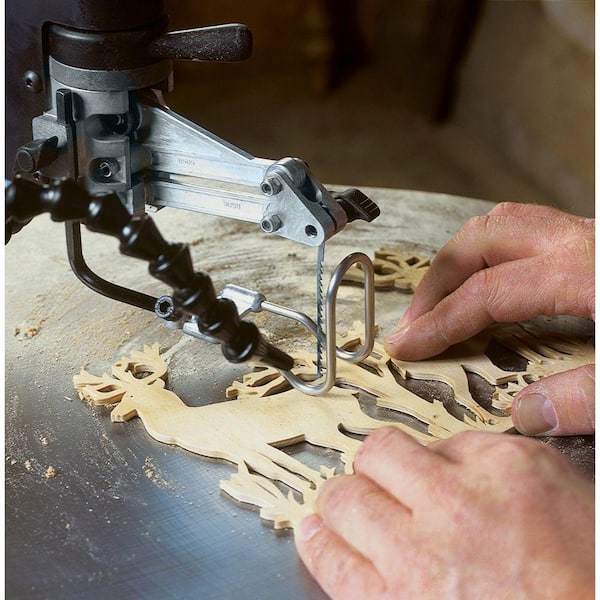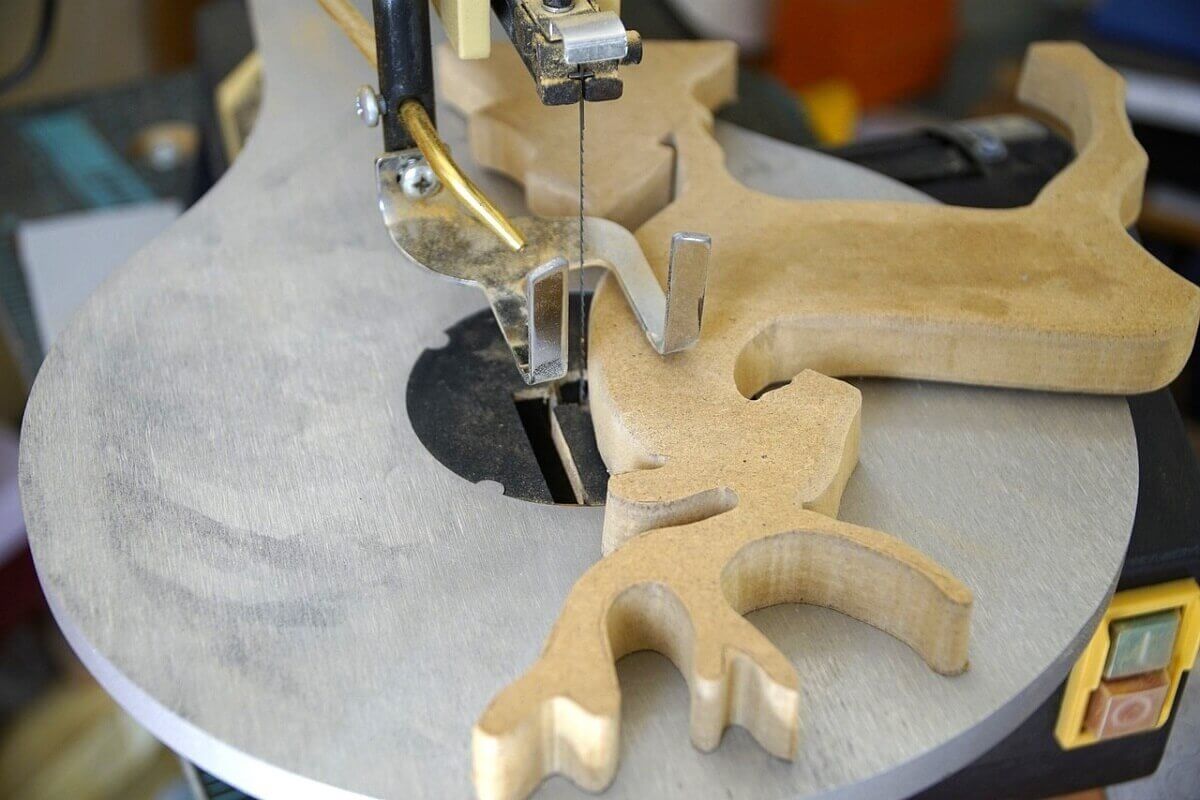When it comes to using a scroll saw, one common question arises: “What type of wood should I use?” Whether you’re a beginner or an experienced woodworker, choosing the right wood is crucial for your projects.
The type of wood you use with a scroll saw can affect the outcome of your cuts, the durability of your finished piece, and even the overall experience of working on your project. So, let’s dive into the world of woodworking and explore the best types of wood to use with a scroll saw.
From hardwoods to softwoods, each type of wood has its own unique features and characteristics. By understanding these qualities, you’ll be able to make informed decisions and achieve outstanding results with your scroll saw projects. So, let’s get started!

The Best Type of Wood to Use with a Scroll Saw: A Comprehensive Guide
Scroll sawing is a popular woodworking technique that allows for intricate and detailed cuts. However, choosing the right type of wood is crucial to achieve the best results with a scroll saw. In this guide, we will explore the different factors to consider when selecting wood for scroll sawing and highlight the best types of wood to use. Whether you are a beginner or an experienced woodworker, this article will provide valuable insights to enhance your scroll sawing projects.
1) Hardwood vs. Softwood: Understanding the Basics
When it comes to choosing wood for scroll sawing, the first consideration is whether to go with hardwood or softwood. Hardwood, as the name suggests, comes from deciduous trees and is known for its durability and strength. Common hardwood options for scroll sawing include maple, walnut, oak, and cherry. On the other hand, softwood is derived from coniferous trees and is generally more affordable and easier to work with. Softwood options suitable for scroll sawing include pine, cedar, and fir.
Each type of wood has its own unique characteristics and working properties. Hardwoods tend to be denser and more resistant to wear, making them ideal for intricate and detailed scroll work. Softwoods, while less dense, are easier to cut and shape, making them a good option for beginners or larger projects. Ultimately, the choice between hardwood and softwood depends on your specific needs and preferences.
2) Factors to Consider When Choosing Wood for Scroll Sawing
In addition to the distinction between hardwood and softwood, there are other factors to consider when selecting wood for scroll sawing. These factors can greatly impact the final outcome of your project and include the following:
- Wood Grain: Pay attention to the grain pattern of the wood. Straight, even grains are typically easier to work with, while irregular grains can pose challenges when making intricate cuts.
- Wood Density: The density of the wood affects the ease of cutting and the level of detail that can be achieved. Dense hardwoods are generally better suited for fine scroll work.
- Wood Color: Consider the natural color of the wood and how it will complement your scroll sawing design. Some woods, like cherry or mahogany, have rich, warm tones that add visual appeal to the finished piece.
- Wood Stability: Certain woods are prone to warping or shrinking when exposed to changes in humidity or temperature. Choose stable woods that are less likely to undergo significant dimensional changes over time.
3) Best Types of Wood for Scroll Sawing
Now that we have covered the basics and the factors to consider, let’s delve into some of the best types of wood for scroll sawing:
a) Maple:
Maple is a popular choice among scroll saw enthusiasts due to its fine texture and smooth finish. It is a hardwood that comes in various colors, including light cream, pale yellow, and reddish brown. Maple is highly stable and has excellent workability, making it suitable for both beginners and experienced woodworkers.
b) Baltic Birch Plywood:
Baltic birch plywood is a versatile material that is widely used in scroll sawing projects. It is known for its exceptional strength, durability, and resistance to warping. Baltic birch plywood is available in various thicknesses and can be easily painted or stained to achieve the desired look.
c) Mahogany:
Mahogany is a tropical hardwood that exhibits a rich, reddish-brown color. It is prized for its straight grain, excellent workability, and resistance to rot and decay. Mahogany is a great choice for scroll sawing projects that require a touch of elegance and sophistication.
d) Walnut:
Walnut is another popular hardwood option for scroll sawing. It features a rich, dark brown color with beautiful grain patterns. Walnut is known for its strength and durability, making it suitable for intricate and detailed scroll work.
e) Pine:
Pine is a softwood that offers a budget-friendly option for scroll sawing projects. It is widely available and easy to work with, making it a popular choice for beginners. Pine has a light color and distinctive grain pattern that adds rustic charm to scroll sawing projects.
Additional Considerations when Choosing Wood for Scroll Saw Projects
Aside from the type of wood, there are a few additional considerations to keep in mind when choosing wood for scroll saw projects:
1) Size and Thickness:
Consider the size and thickness of the wood you will be using. Thicker woods may require more time and effort to cut, while smaller pieces may limit the level of detail you can achieve.
2) Availability and Cost:
Take into account the availability and cost of the wood species you are considering. Some exotic woods may be harder to find or more expensive, while others are readily available at affordable prices.
3) Personal Preference:
Ultimately, your personal preference and artistic vision play a significant role in selecting the right wood for your scroll saw projects. Consider the overall aesthetic you want to achieve and choose a wood species that aligns with your creative vision.
By carefully considering these factors and exploring the best types of wood for scroll sawing, you can enhance the quality and beauty of your scroll saw projects. Remember to always practice proper safety measures and enjoy the process of creating stunning works of art with your scroll saw and the perfect type of wood!
Key Takeaways: What Type of Wood to Use with Scroll Saw?
- Choose a softwood like pine or poplar for beginners.
- Hardwoods like oak or mahogany are great for intricate designs.
- Avoid wood with knots as it may cause problems while cutting.
- Consider the thickness of the wood depending on your project.
- Always wear safety goggles and use a dust mask when working with wood.
Frequently Asked Questions
Choosing the right type of wood for your scroll saw is crucial to ensure the best results for your projects. Here are five commonly asked questions about the type of wood to use with a scroll saw.
1. What are the best types of wood for scroll saw projects?
When it comes to scroll saw projects, the best types of wood are those that are relatively soft and have a consistent grain. Woods like pine, cedar, and basswood are popular choices for scroll sawing due to their softness, ease of cutting, and availability. These woods also tend to have straight, even grain patterns, making them suitable for intricate cuts. Birch and maple are also good options, but they are slightly harder and may require more effort to cut.
Ultimately, the best type of wood for your scroll saw projects depends on your personal preference and the specific design you want to create. It’s a good idea to experiment with different types of wood to find what works best for you.
2. Can I use hardwoods with a scroll saw?
While hardwoods are generally more challenging to cut with a scroll saw due to their denser nature, it is still possible to use them for certain projects. Hardwoods like oak, cherry, and walnut can create stunning and durable scroll saw projects, but they require more precision and patience. It’s important to choose thin cuts and use sharp blades when working with hardwoods to achieve cleaner cuts. Additionally, using a slower cutting speed can also help prevent burning and keep the wood from splintering.
If you’re a beginner, it’s recommended to start with softer woods before attempting projects with hardwoods. With practice and experience, you can gradually develop the skills to work with hardwoods on your scroll saw.
3. Are there any woods I should avoid using with a scroll saw?
While most woods can be used with a scroll saw, there are a few types to be cautious about. Extremely hard and dense woods, such as rosewood or certain exotic woods, can cause excessive wear on the saw blades and make cutting difficult. These woods may also produce more heat, leading to burning on the edges of your cuts. Additionally, using woods that are prone to splintering or have irregular grain patterns may result in less precise cuts.
It’s always a good idea to consult woodworking professionals, online forums, or communities for recommendations on which woods to avoid with a scroll saw. This can help you save time, effort, and potential frustration on your projects.
4. Can I use plywood with a scroll saw?
Yes, plywood can be used with a scroll saw, but it’s important to choose the right type. Opt for high-quality plywood that has thin layers and a smooth surface. Thicker plywood can be more challenging to cut and may require more power from the scroll saw. Avoid using plywood with voids or gaps between layers, as this can cause instability and uneven cuts. It’s also a good practice to sand the edges of the plywood after cutting to achieve a smooth finish.
Keep in mind that the type and quality of plywood can vary, so it’s best to experiment and find the brands or types that work well with your scroll saw.
5. How should I prepare the wood before using a scroll saw?
Before cutting with a scroll saw, it’s important to prepare the wood properly. Start by ensuring the wood is clean, free from any dirt or debris that can hinder the blade’s performance. If necessary, sand the surface of the wood to remove any rough areas or imperfections. This will help prevent the saw blade from snagging or getting stuck during cutting.
It’s also a good idea to apply a finish or sealant to the wood after cutting to protect it and enhance its appearance. This can be done with varnish, paint, or wood conditioner, depending on your desired outcome. Remember to allow the finish to dry completely before handling or using the piece in your project.

Summary
Choosing the right wood for your scroll saw projects is important. Softwoods like pine are great for beginners because they’re easy to work with. Hardwoods like oak and maple are better for intricate designs but may be more challenging to cut. Some woods may have toxic fumes, so always research before using them. Remember, practice makes perfect, so don’t be afraid to experiment with different types of wood to find what works best for you. Happy scrolling!
In conclusion, when choosing wood for your scroll saw projects, consider the difficulty level, toxicity, and your skill level. Softwoods are good for beginners, while hardwoods are better for detailed work. Research the type of wood you plan to use to ensure it’s safe. Keep practicing and trying new woods to improve your scrolling skills and create beautiful projects. Enjoy the process!
